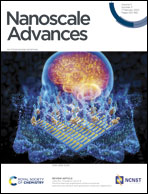Integration of photovoltaic and photogating effects in a WSe2/WS2/p-Si dual junction photodetector featuring high-sensitivity and fast-response†
Abstract
Two-dimensional (2D) material-based van der Waals (vdW) heterostructures with exotic semiconducting properties have shown tremendous potential in next-generation photovoltaic photodetectors. Nevertheless, these vdW heterostructure devices inevitably suffer from a compromise between high sensitivity and fast response. Herein, an ingenious photovoltaic photodetector based on a WSe2/WS2/p-Si dual-vdW heterojunction is demonstrated. First-principles calculations and energy band profiles consolidate that the photogating effect originating from the bottom vdW heterojunction not only strengthens the photovoltaic effect of the top vdW heterojunction, but also suppresses the recombination of photogenerated carriers. As a consequence, the separation of photogenerated carriers is facilitated and their lifetimes are extended, resulting in higher photoconductive gain. Coupled with these synergistic effects, this WSe2/WS2/p-Si device exhibits both high sensitivity (responsivity of 340 mA W−1, a light on/off ratio greater than 2500, and a detectivity of 3.34 × 1011 Jones) and fast response time (rise/decay time of 657/671 μs) under 405 nm light illumination in self-powered mode. Finally, high-resolution visible-light and near-infrared imaging capabilities are demonstrated by adopting this dual-heterojunction device as a single pixel, indicating its great application prospects in future optoelectronic systems.



 Please wait while we load your content...
Please wait while we load your content...